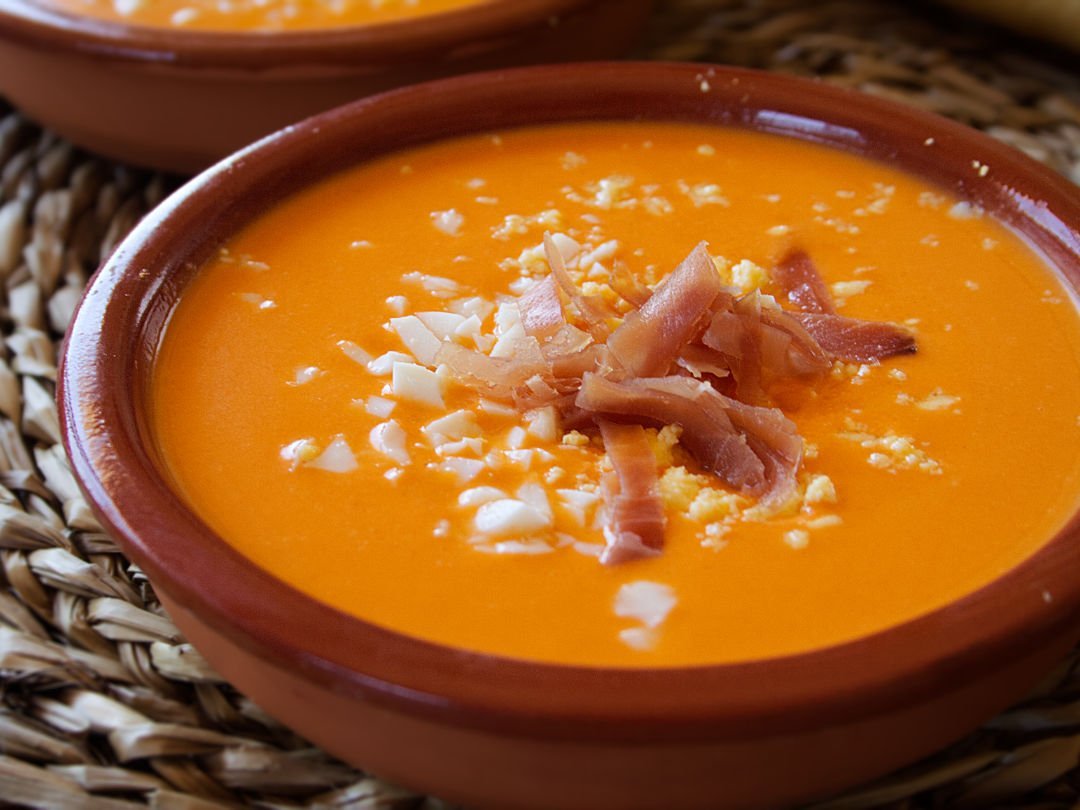On a vibrant journey steeped in the sun-drenched hues of Spain, I discovered not just the beauty of its landscapes but also the zest of its culinary heritage – Salmorejo. This Spanish cold tomato soup, a marvel of simplicity and taste, harmoniously blends ripe tomatoes with the rich textures of eggs and serrano ham, creating a refreshing yet deeply satisfying dish. Amid the backdrop of bustling markets and the serene Mediterranean, the discovery of Salmorejo was a palate-enlightening moment. The tomatoes offered a juicy, tangy base, complemented by the soft, boiled eggs and thinly sliced serrano ham, which added layers of flavor and a touch of saltiness that was nothing short of culinary poetry. Inspired by this quintessentially Spanish dish, I embarked on a quest to replicate the authentic taste and share a piece of my journey. After honing the recipe to strike the right balance between acidity and richness, I’m eager to pass on this slice of Spanish summer. Through this Salmorejo recipe, you’re invited to dive into the refreshing essence of Spain’s gastronomy, bringing the vibrancy and warmth of my travels directly to your table.

Salmorejo
Equipment
- 1 big pot
Ingredients
- 2 hardboiled eggs
- Diced serrano ham
- A splash of sherry vinegar
- A pinch of salt
- 8 medium tomatoes
- 1 cup olive oil again
- 1 clove of garlic
- 1 medium baguette
Instructions
- Carry a big pot of salted water to a boil on the burner.
- In the base of each tomato, make a small symbol.
- Remove the cores from the tomatoes and mix everything else.
- Use a high-powered blender, combine all ingredients.
- Remove the “guts” from your baguette and toss them in with the blended vegetables.
- Mix in the drop of vinegar, pepper, and garlic until the soup has even consistency.
- Mix in 1 hardboiled egg until completely combined.
- Offer in big containers with toppings of diced poblano pepper and diced ham. Serve chilled.
Cooking Tips about Salmorejo

- Selecting Tomatoes: The success of Salmorejo largely depends on the quality and ripeness of the tomatoes. Opt for ripe, juicy tomatoes that are rich in flavor. The sweeter and more flavorful the tomato, the better your soup will taste. Summer is the best season to find tomatoes that will do your Salmorejo justice.
- Bread Choice: Use a white bread with a good structure but without a hard crust, as it needs to blend smoothly into the soup. Day-old bread is ideal as its slightly dried texture absorbs the tomato juices better, adding body to the Salmorejo without overshadowing the tomato flavor.
- Garlic Adjustment: A raw garlic clove adds a sharp depth to the soup, but its intensity can vary widely. Start with a small amount and adjust according to your taste preferences. If you’re not a fan of raw garlic’s punch, blanch the garlic clove quickly in boiling water to tame its bite.
- Olive Oil Emulsion: The olive oil should be of high quality, preferably extra virgin, with a fruity aroma to complement the sweetness of the tomatoes. When blending the soup, add the olive oil slowly to create an emulsion. This process gives Salmorejo its characteristic creamy texture without using cream or dairy.
- Chilling Time: Once blended, chill the Salmorejo for at least an hour before serving. This soup is best enjoyed cold, allowing the flavors to meld together and the soup to refresh and invigorate the palette on a hot day.
- Seasoning: Balance is key in Salmorejo. After blending, taste and adjust the seasoning with salt and a dash of sherry vinegar if desired. The vinegar can enhance the natural sweetness of the tomatoes and add a layer of complexity to the soup.
- Garnishes: Traditional garnishes include hard-boiled egg and jamón Serrano (a type of dry-cured Spanish ham), finely chopped or crumbled over the top. These toppings add contrasting textures and flavors — the richness of the egg and the salty savoriness of the ham complement the smooth, chilled soup beautifully.
- Serving Suggestions: Serve Salmorejo in chilled bowls to keep it cool and refreshing. It can be a starter for a larger meal or a light lunch on its own. Pair it with a crisp, dry Spanish white wine like Albariño or Verdejo for a harmonious dining experience.
Serving suggestions about Salmorejo

- Chilled Presentation: Serve Salmorejo in individual chilled bowls or deep dishes to keep it refreshingly cold. Pre-chilling the serving vessels ensures the soup maintains its cool temperature, enhancing the flavors and offering respite from the warmth of a sunny day.
- Garnish with Tradition: Top each serving of Salmorejo with finely chopped hard-boiled eggs and thinly sliced serrano ham for a burst of flavor and a nod to the traditional garnishes that complement the creamy texture of the soup. These elements add a delightful contrast and complexity to every spoonful.
- Drizzle of Quality Olive Oil: A light drizzle of high-quality extra virgin olive oil just before serving can elevate the taste, adding a fruity aroma and a silky mouthfeel that balances the acidity of the tomatoes.
- Fresh Bread on the Side: Offer slices of rustic or sourdough bread on the side, perfect for dipping into the soup. The bread can absorb the flavors and textures, making for a satisfying and cohesive dining experience.
- Pair with Spanish Wines: Complement the rich and tangy flavors of Salmorejo with a chilled glass of Spanish white wine, such as Albariño or Verdejo. The crispness and acidity of these wines can beautifully balance the richness of the soup, creating a harmonious meal.
- Ambient Setting: Enhance your dining experience by creating a setting that transports you and your guests to Spain. Consider dining al fresco, decorating your table with vibrant colors reminiscent of a Spanish fiesta, and playing some flamenco guitar music in the background to capture the essence and joy of Spanish dining culture.
- Serve as a Starter or Light Meal: While Salmorejo can stand alone as a refreshing light meal, it’s traditionally served as a starter. Pair it with other Spanish dishes like tortilla española (Spanish omelet) or a selection of tapas for a full Spanish feast that encourages leisurely dining and conversation.
Top 5 FAQs about Salmorejo

- What is the difference between Salmorejo and Gazpacho? Although both are chilled soups from Spain, Salmorejo and Gazpacho differ significantly in texture and ingredients. Gazpacho is a thinner soup and has a larger variety of vegetables like cucumbers and peppers, in addition to tomatoes. Salmorejo, on the other hand, is thicker due to the greater proportion of bread in the recipe. Gazpacho is often served as a drink, while Salmorejo is decidedly a spoonable dish. Furthermore, Salmorejo garnishes typically include hard-boiled eggs and ham, providing a contrast in flavor and texture that’s not commonly found in Gazpacho presentations.
- What are the health benefits of Salmorejo? Salmorejo is rich in vitamins and antioxidants due to its primary ingredient, tomatoes. Tomatoes are a great source of vitamin C, potassium, folate, and vitamin K. The olive oil used in Salmorejo is high in monounsaturated fats, which are known to promote heart health. Additionally, because it’s served cold, none of the nutrients are lost to heat during cooking, making Salmorejo not only wholesome but also a refreshing way to enjoy raw nutrients.
- Can Salmorejo be made vegan? Traditional Salmorejo recipes include hard-boiled egg and jamón, but the soup itself is vegetarian and can easily be adapted to a vegan diet by omitting or substituting the garnishes. For a vegan version, one might use avocado or vegan ham as a topping to mimic the creaminess and savory notes of the traditional garnishes. The base ingredients of tomatoes, bread, olive oil, garlic, and vinegar are naturally vegan.
- How do you serve Salmorejo? Salmorejo is typically served chilled as a starter or light meal, especially in the warmer months. It is poured into bowls and garnished with finely chopped hard-boiled eggs and thinly sliced jamón. For additional flavor and a beautiful finishing touch, a drizzle of good quality extra virgin olive oil is often added. It’s essential to chill the soup for several hours before serving to allow the flavors to meld and the soup to achieve the right consistency and temperature.
- Can Salmorejo be stored and if so, for how long? Yes, Salmorejo can be stored in the refrigerator for up to 2-3 days. It should be placed in an airtight container to maintain its freshness and prevent it from absorbing other flavors from the fridge. It’s recommended to add the garnishes just before serving to preserve their texture and flavor. As with any dish containing fresh ingredients, it’s important to check the soup before consumption if it’s been stored for a couple of days to ensure it’s still good to eat.
In wrapping up the essence of Salmorejo, we’ve journeyed through the heart of Spain’s culinary traditions to discover a dish that captures the soul of Spanish summers. This cold tomato soup, with its smooth, creamy texture and rich blend of ripe tomatoes, boiled eggs, and thin slices of serrano ham, stands as a testament to the simplicity and elegance of Spanish cuisine. Perfect for warm days, Salmorejo offers not just a cooling respite but a celebration of fresh, vibrant flavors that speak to the joy of sharing and the pleasure of eating well.

Leave a Reply